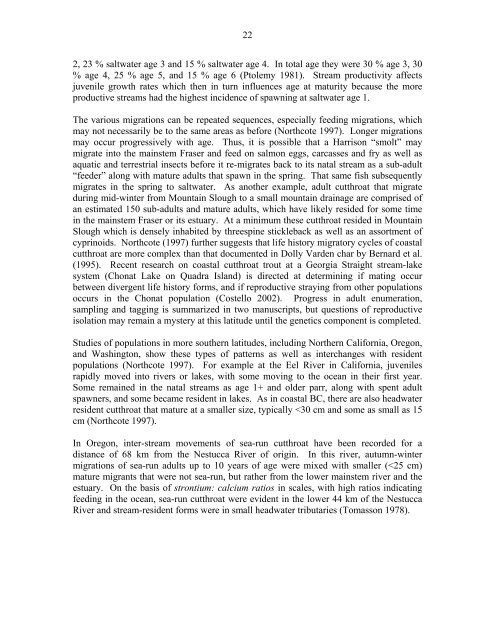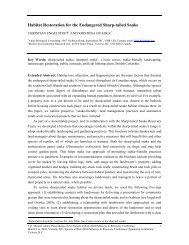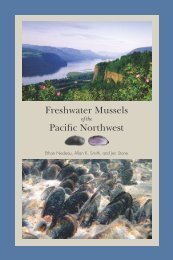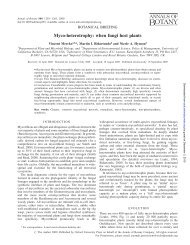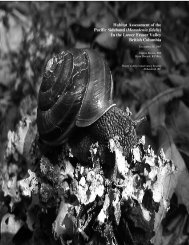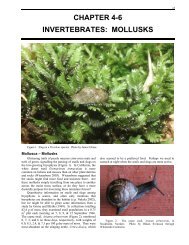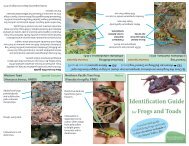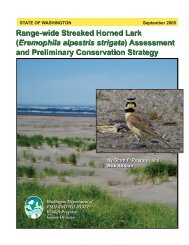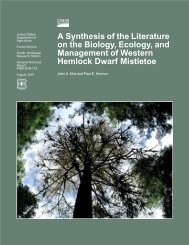Coastal Cutthroat Trout as Sentinels of Lower Mainland Watershed ...
Coastal Cutthroat Trout as Sentinels of Lower Mainland Watershed ...
Coastal Cutthroat Trout as Sentinels of Lower Mainland Watershed ...
You also want an ePaper? Increase the reach of your titles
YUMPU automatically turns print PDFs into web optimized ePapers that Google loves.
222, 23 % saltwater age 3 and 15 % saltwater age 4. In total age they were 30 % age 3, 30% age 4, 25 % age 5, and 15 % age 6 (Ptolemy 1981). Stream productivity affectsjuvenile growth rates which then in turn influences age at maturity because the moreproductive streams had the highest incidence <strong>of</strong> spawning at saltwater age 1.The various migrations can be repeated sequences, especially feeding migrations, whichmay not necessarily be to the same are<strong>as</strong> <strong>as</strong> before (Northcote 1997). Longer migrationsmay occur progressively with age. Thus, it is possible that a Harrison “smolt” maymigrate into the mainstem Fr<strong>as</strong>er and feed on salmon eggs, carc<strong>as</strong>ses and fry <strong>as</strong> well <strong>as</strong>aquatic and terrestrial insects before it re-migrates back to its natal stream <strong>as</strong> a sub-adult“feeder” along with mature adults that spawn in the spring. That same fish subsequentlymigrates in the spring to saltwater. As another example, adult cutthroat that migrateduring mid-winter from Mountain Slough to a small mountain drainage are comprised <strong>of</strong>an estimated 150 sub-adults and mature adults, which have likely resided for some timein the mainstem Fr<strong>as</strong>er or its estuary. At a minimum these cutthroat resided in MountainSlough which is densely inhabited by threespine stickleback <strong>as</strong> well <strong>as</strong> an <strong>as</strong>sortment <strong>of</strong>cyprinoids. Northcote (1997) further suggests that life history migratory cycles <strong>of</strong> co<strong>as</strong>talcutthroat are more complex than that documented in Dolly Varden char by Bernard et al.(1995). Recent research on co<strong>as</strong>tal cutthroat trout at a Georgia Straight stream-lakesystem (Chonat Lake on Quadra Island) is directed at determining if mating occurbetween divergent life history forms, and if reproductive straying from other populationsoccurs in the Chonat population (Costello 2002). Progress in adult enumeration,sampling and tagging is summarized in two manuscripts, but questions <strong>of</strong> reproductiveisolation may remain a mystery at this latitude until the genetics component is completed.Studies <strong>of</strong> populations in more southern latitudes, including Northern California, Oregon,and W<strong>as</strong>hington, show these types <strong>of</strong> patterns <strong>as</strong> well <strong>as</strong> interchanges with residentpopulations (Northcote 1997). For example at the Eel River in California, juvenilesrapidly moved into rivers or lakes, with some moving to the ocean in their first year.Some remained in the natal streams <strong>as</strong> age 1+ and older parr, along with spent adultspawners, and some became resident in lakes. As in co<strong>as</strong>tal BC, there are also headwaterresident cutthroat that mature at a smaller size, typically


